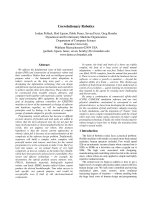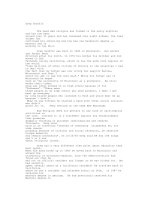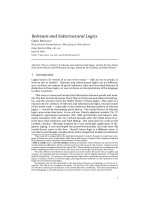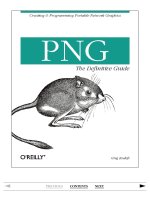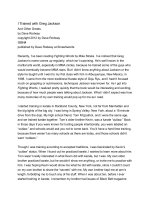essentialism greg mckeown
Bạn đang xem bản rút gọn của tài liệu. Xem và tải ngay bản đầy đủ của tài liệu tại đây (1.76 MB, 161 trang )
Copyright © 2014 by Greg McKeown
All rights reserved.
Published in the United States by Crown Business, an imprint of the Crown Publishing Group, a division of Random House LLC, a
Penguin Random House Company, New York. www.crownpublishing.com
CROWN BUSINESS is a trademark and CROWN and the Rising Sun colophon are registered trademarks of Random House LLC.
Library of Congress Cataloging-in-Publication Data
McKeown, Greg
pages cm
1. Choice (Psychology) 2. Decision making. 3. Essentialism
BF611.M455 2014
153.8/3 2012001733
ISBN 978-0-8041-3738-6
eBook ISBN 978-0-8041-3739-3
Illustrations and jacket design by Amy Hayes Stellhorn and her team at Big Monocle in collaboration with Maria Elias.
v3.1
DEDICATED TO
ANNA
GRACE
EVE
JACK
AND ESTHER
YOU PERSONIFY EVERYTHING
THAT IS ESSENTIAL TO ME.
CONTENTS
Cover
Title Page
Copyright
Dedication
1. The Essentialist
Part I: Essence: What is the core mind-set of an Essentialist?
2. CHOOSE: The Invincible Power of Choice
3. DISCERN: The Unimportance of Practically Everything
4. TRADE-OFF: Which Problem Do I Want?
Part II: Explore: How can we discern the trivial many from the vital few?
5. ESCAPE: The Perks of Being Unavailable
6. LOOK: See What Really Matters
7. PLAY: Embrace the Wisdom of Your Inner Child
8. SLEEP: Protect the Asset
9. SELECT: The Power of Extreme Criteria
Part III: Eliminate: How can we cut out the trivial many?
10. CLARIFY: One Decision That Makes a Thousand
11. DARE: The Power of a Graceful “No”
12. UNCOMMIT: Win Big by Cutting Your Losses
13. EDIT: The Invisible Art
14. LIMIT: The Freedom of Setting Boundaries
Part IV: Execute: How can we make doing the vital few things almost effortless?
15. BUFFER: The Unfair Advantage
16. SUBTRACT: Bring Forth More by Removing Obstacles
17. PROGRESS: The Power of Small Wins
18. FLOW: The Genius of Routine
19. FOCUS: What’s Important Now?
20. BE: The Essentialist Life
Appendix
Leadership Essentials
Notes
Acknowledgments
Taking Essentialism Beyond the Page
CHAPTER 1
The Essentialist
THE WISDOM OF LIFE CONSISTS IN THE ELIMINATION OF NON-ESSENTIALS.
—Lin Yutang
Sam Elliot
*
is a capable executive in Silicon Valley who found himself stretched too thin after his
company was acquired by a larger, bureaucratic business.
He was in earnest about being a good citizen in his new role so he said yes to many requests
without really thinking about it. But as a result he would spend the whole day rushing from one
meeting and conference call to another trying to please everyone and get it all done. His stress went
up as the quality of his work went down. It was like he was majoring in minor activities and as a
result, his work became unsatisfying for him and frustrating for the people he was trying so hard to
please.
In the midst of his frustration the company came to him and offered him an early retirement
package. But he was in his early 50s and had no interest in completely retiring. He thought briefly
about starting a consulting company doing what he was already doing. He even thought of selling his
services back to his employer as a consultant. But none of these options seemed that appealing. So he
went to speak with a mentor who gave him surprising advice: “Stay, but do what you would as a
consultant and nothing else. And don’t tell anyone.” In other words, his mentor was advising him to
do only those things that he deemed essential—and ignore everything else that was asked of him.
The executive followed the advice! He made a daily commitment towards cutting out the red tape.
He began saying no.
He was tentative at first. He would evaluate requests based on the timid criteria, “Can I actually
fulfill this request, given the time and resources I have?” If the answer was no then he would refuse
the request. He was pleasantly surprised to find that while people would at first look a little
disappointed, they seemed to respect his honesty.
Encouraged by his small wins he pushed back a bit more. Now when a request would come in he
would pause and evaluate the request against a tougher criteria: “Is this the very most important thing
I should be doing with my time and resources right now?”
If he couldn’t answer a definitive yes, then he would refuse the request. And once again to his
delight, while his colleagues might initially seem disappointed, they soon began to respect him more
for his refusal, not less.
Emboldened, he began to apply this selective criteria to everything, not just direct requests. In his
past life he would always volunteer for presentations or assignments that came up last minute; now he
found a way to not sign up for them. He used to be one of the first to jump in on an e-mail trail, but
now he just stepped back and let others jump in. He stopped attending conference calls that he only
had a couple of minutes of interest in. He stopped sitting in on the weekly update call because he
didn’t need the information. He stopped attending meetings on his calendar if he didn’t have a direct
contribution to make. He explained to me, “Just because I was invited didn’t seem a good enough
reason to attend.”
It felt self-indulgent at first. But by being selective he bought himself space, and in that space he
found creative freedom. He could concentrate his efforts on one project at a time. He could plan
thoroughly. He could anticipate roadblocks and start to remove obstacles. Instead of spinning his
wheels trying to get everything done, he could get the right things done. His newfound commitment to
doing only the things that were truly important—and eliminating everything else—restored the quality
of his work. Instead of making just a millimeter of progress in a million directions he began to
generate tremendous momentum towards accomplishing the things that were truly vital.
He continued this for several months. He immediately found that he not only got more of his day
back at work, in the evenings he got even more time back at home. He said, “I got back my family life!
I can go home at a decent time.” Now instead of being a slave to his phone he shuts it down. He goes
to the gym. He goes out to eat with his wife.
To his great surprise, there were no negative repercussions to his experiment. His manager didn’t
chastise him. His colleagues didn’t resent him. Quite the opposite; because he was left only with
projects that were meaningful to him and actually valuable to the company, they began to respect and
value his work more than ever. His work became fulfilling again. His performance ratings went up.
He ended up with one of the largest bonuses of his career!
In this example is the basic value proposition of Essentialism: only once you give yourself
permission to stop trying to do it all, to stop saying yes to everyone, can you make your highest
contribution towards the things that really matter.
What about you? How many times have you reacted to a request by saying yes without really
thinking about it? How many times have you resented committing to do something and wondered,
“Why did I sign up for this?” How often do you say yes simply to please? Or to avoid trouble? Or
because “yes” had just become your default response?
Now let me ask you this: Have you ever found yourself stretched too thin? Have you ever felt both
overworked and underutilized? Have you ever found yourself majoring in minor activities? Do you
ever feel busy but not productive? Like you’re always in motion, but never getting anywhere?
If you answered yes to any of these, the way out is the way of the Essentialist.
The Way of the Essentialist
Dieter Rams was the lead designer at Braun for many years. He is driven by the idea that almost
everything is noise. He believes very few things are essential. His job is to filter through that noise
until he gets to the essence. For example, as a young twenty-four-year-old at the company he was
asked to collaborate on a record player. The norm at the time was to cover the turntable in a solid
wooden lid or even to incorporate the player into a piece of living room furniture. Instead, he and his
team removed the clutter and designed a player with a clear plastic cover on the top and nothing
more. It was the first time such a design had been used, and it was so revolutionary people worried it
might bankrupt the company because nobody would buy it. It took courage, as it always does, to
eliminate the nonessential. By the sixties this aesthetic started to gain traction. In time it became the
design every other record player followed.
Dieter’s design criteria can be summarized by a characteristically succinct principle, captured in
just three German words: Weniger aber besser . The English translation is: Less but better. A more
fitting definition of Essentialism would be hard to come by.
The way of the Essentialist is the relentless pursuit of less but better. It doesn’t mean occasionally
giving a nod to the principle. It means pursuing it in a disciplined way.
The way of the Essentialist isn’t about setting New Year’s resolutions to say “no” more, or about
pruning your in-box, or about mastering some new strategy in time management. It is about pausing
constantly to ask, “Am I investing in the right activities?” There are far more activities and
opportunities in the world than we have time and resources to invest in. And although many of them
may be good, or even very good, the fact is that most are trivial and few are vital. The way of the
Essentialist involves learning to tell the difference—learning to filter through all those options and
selecting only those that are truly essential.
Essentialism is not about how to get more things done; it’s about how to get the right things done. It
doesn’t mean just doing less for the sake of less either. It is about making the wisest possible
investment of your time and energy in order to operate at our highest point of contribution by doing
only what is essential.
The difference between the way of the Essentialist and the way of the Nonessentialist can be seen
in the figure opposite. In both images the same amount of effort is exerted. In the image on the left, the
energy is divided into many different activities. The result is that we have the unfulfilling experience
of making a millimeter of progress in a million directions. In the image on the right, the energy is
given to fewer activities. The result is that by investing in fewer things we have the satisfying
experience of making significant progress in the things that matter most. The way of the Essentialist
rejects the idea that we can fit it all in. Instead it requires us to grapple with real trade-offs and make
tough decisions. In many cases we can learn to make one-time decisions that make a thousand future
decisions so we don’t exhaust ourselves asking the same questions again and again.
The way of the Essentialist means living by design, not by default. Instead of making choices
reactively, the Essentialist deliberately distinguishes the vital few from the trivial many, eliminates
the nonessentials, and then removes obstacles so the essential things have clear, smooth passage. In
other words, Essentialism is a disciplined, systematic approach for determining where our highest
point of contribution lies, then making execution of those things almost effortless.
The Model
Nonessentialist Essentialist
Thinks
ALL THINGS TO ALL PEOPLE
“I have to.”
“It’s all important.”
“How can I fit it all in?”
LESS BUT BETTER
“I choose to.”
“Only a few things really matter.”
“What are the trade-offs?”
Does
THE UNDISCIPLINED PURSUIT OF
MORE
Reacts to what’s most pressing
Says “yes” to people without really
thinking
Tries to force execution at the last moment
THE DISCIPLINED PURSUIT OF LESS
Pauses to discern what really matters
Says “no” to everything except the essential
Removes obstacles to make execution easy
Gets
LIVES A LIFE THAT DOES
NOT SATISFY
Takes on too much, and work suffers
Feels out of control
Is unsure of whether the right things got
done
Feels overwhelmed and exhausted
LIVES A LIFE THAT REALLY MATTERS
Chooses carefully in order to do great work
Feels in control
Gets the right things done Experiences joy in the
journey
The way of the Essentialist is the path to being in control of our own choices. It is a path to new
levels of success and meaning. It is the path on which we enjoy the journey, not just the destination.
Despite all these benefits, however, there are too many forces conspiring to keep us from applying the
disciplined pursuit of less but better, which may be why so many end up on the misdirected path of
the Nonessentialist.
The Way of the Nonessentialist
On a bright, winter day in California I visited my wife, Anna, in the hospital. Even in the hospital
Anna was radiant. But I also knew she was exhausted. It was the day after our precious daughter was
born, healthy and happy at 7 pounds, 3 ounces.
1
Yet what should have been one of the happiest, most serene days of my life was actually filled with
tension. Even as my beautiful new baby lay in my wife’s tired arms, I was on the phone and on e-mail
with work, and I was feeling pressure to go to a client meeting. My colleague had written, “Friday
between 1–2 would be a bad time to have a baby because I need you to come be at this meeting with
X.” It was now Friday and though I was pretty certain (or at least I hoped) the e-mail had been
written in jest, I still felt pressure to attend.
Instinctively, I knew what to do. It was clearly a time to be there for my wife and newborn child.
So when asked whether I planned to attend the meeting, I said with all the conviction I could
muster …
“Yes.”
To my shame, while my wife lay in the hospital with our hours-old baby, I went to the meeting.
Afterward, my colleague said, “The client will respect you for making the decision to be here.” But
the look on the clients’ faces did not evince respect. Instead, they mirrored how I felt. What was I
doing there? I had said “yes” simply to please, and in doing so I had hurt my family, my integrity, and
even the client relationship.
As it turned out, exactly nothing came of the client meeting. But even if it had, surely I would have
made a fool’s bargain. In trying to keep everyone happy I had sacrificed what mattered most.
On reflection I discovered this important lesson:
If you don’t prioritize your life, someone else
will.
That experience gave me renewed interest—read, inexhaustible obsession—in understanding why
otherwise intelligent people make the choices they make in their personal and professional lives.
“Why is it,” I wonder, “that we have so much more ability inside of us than we often choose to
utilize?” And “How can we make the choices that allow us to tap into more of the potential inside
ourselves, and in people everywhere?”
My mission to shed light on these questions had already led me to quit law school in England and
travel, eventually, to California to do my graduate work at Stanford. It had led me to spend more than
two years collaborating on a book, Multipliers: How the Best Leaders Make Everyone Smarter.
And it went on to inspire me to start a strategy and leadership company in Silicon Valley, where I
now work with some of the most capable people in some of the most interesting companies in the
world, helping to set them on the path of the Essentialist.
In my work I have seen people all over the world who are consumed and overwhelmed by the
pressures all around them. I have coached “successful” people in the quiet pain of trying desperately
to do everything, perfectly, now. I have seen people trapped by controlling managers and unaware
that they do not “have to” do all the thankless busywork they are asked to do. And I have worked
tirelessly to understand why so many bright, smart, capable individuals remain snared in the death
grip of the nonessential.
What I have found has surprised me.
I worked with one particularly driven executive who got into technology at a young age and loved
it. He was quickly rewarded for his knowledge and passion with more and more opportunities. Eager
to build on his success, he continued to read as much as he could and pursue all he could with gusto
and enthusiasm. By the time I met him he was hyperactive, trying to learn it all and do it all. He
seemed to find a new obsession every day, sometimes every hour. And in the process, he lost his
ability to discern the vital few from the trivial many. Everything was important. As a result he was
stretched thinner and thinner. He was making a millimeter of progress in a million directions. He was
overworked and underutilized. That’s when I sketched out for him the image on the left in the figure
on this page.
He stared at it for the longest time in uncharacteristic silence. Then he said, with more than a hint
of emotion, “That is the story of my life!” Then I sketched the image on the right. “What would happen
if we could figure out the one thing you could do that would make the highest contribution?” I asked
him. He responded sincerely: “That is the question.”
As it turns out, many intelligent, ambitious people have perfectly legitimate reasons to have trouble
answering this question. One reason is that in our society we are punished for good behavior (saying
no) and rewarded for bad behavior (saying yes). The former is often awkward in the moment, and the
latter is often celebrated in the moment. It leads to what I call “the paradox of success,”
2
which can
be summed up in four predictable phases:
PHASE 1: When we really have clarity of purpose, it enables us to succeed at our endeavor.
PHASE 2: When we have success, we gain a reputation as a “go to” person. We become “good old
[insert name],” who is always there when you need him, and we are presented with increased options
and opportunities.
PHASE 3: When we have increased options and opportunities, which is actually code for demands
upon our time and energies, it leads to diffused efforts. We get spread thinner and thinner.
PHASE 4: We become distracted from what would otherwise be our highest level of contribution.
The effect of our success has been to undermine the very clarity that led to our success in the first
place.
Curiously, and overstating the point in order to make it, the pursuit of success can be a catalyst
for failure. Put another way, success can distract us from focusing on the essential things that produce
success in the first place.
We can see this everywhere around us. In his book How the Mighty Fall, Jim Collins explores
what went wrong in companies that were once darlings of Wall Street but later collapsed.
3
He finds
that for many, falling into “the undisciplined pursuit of more” was a key reason for failure. This is
true for companies and it is true for the people who work in them. But why?
Why Nonessentialism Is Everywhere
Several trends have combined to create a perfect Nonessentialist storm. Consider the following.
TOO MANY CHOICES
We have all observed the exponential increase in choices over the last decade. Yet even in the midst
of it, and perhaps because of it, we have lost sight of the most important ones.
As Peter Drucker said, “In a few hundred years, when the history of our time will be written from a
long-term perspective, it is likely that the most important event historians will see is not technology,
not the Internet, not e-commerce. It is an unprecedented change in the human condition. For the first
time—literally—substantial and rapidly growing numbers of people have choices. For the first time,
they will have to manage themselves. And society is totally unprepared for it.”
4
We are unprepared in part because, for the first time, the preponderance of choice has
overwhelmed our ability to manage it. We have lost our ability to filter what is important and what
isn’t. Psychologists call this “decision fatigue”: the more choices we are forced to make, the more the
quality of our decisions deteriorates.
5
TOO MUCH SOCIAL PRESSURE
It is not just the number of choices that has increased exponentially, it is also the strength and number
of outside influences on our decisions that has increased. While much has been said and written about
how hyperconnected we now are and how distracting this information overload can be, the larger
issue is how our connectedness has increased the strength of social pressure. Today, technology has
lowered the barrier for others to share their opinion about what we should be focusing on. It is not
just information overload; it is opinion overload.
THE IDEA THAT “YOU CAN HAVE IT ALL”
The idea that we can have it all and do it all is not new. This myth has been peddled for so long, I
believe virtually everyone alive today is infected with it. It is sold in advertising. It is championed in
corporations. It is embedded in job descriptions that provide huge lists of required skills and
experience as standard. It is embedded in university applications that require dozens of
extracurricular activities.
What is new is how especially damaging this myth is today, in a time when choice and expectations
have increased exponentially. It results in stressed people trying to cram yet more activities into their
already overscheduled lives. It creates corporate environments that talk about work/life balance but
still expect their employees to be on their smart phones 24/7/365. It leads to staff meetings where as
many as ten “top priorities” are discussed with no sense of irony at all.
The word priority came into the English language in the 1400s. It was singular. It meant the very
first or prior thing. It stayed singular for the next five hundred years. Only in the 1900s did we
pluralize the term and start talking about priorities. Illogically, we reasoned that by changing the
word we could bend reality. Somehow we would now be able to have multiple “first” things. People
and companies routinely try to do just that. One leader told me of his experience in a company that
talked of “Pri-1, Pri-2, Pri-3, Pri-4, and Pri-5.” This gave the impression of many things being the
priority but actually meant nothing was.
But when we try to do it all and have it all, we find ourselves making trade-offs at the margins that
we would never take on as our intentional strategy. When we don’t purposefully and deliberately
choose where to focus our energies and time, other people—our bosses, our colleagues, our clients,
and even our families—will choose for us, and before long we’ll have lost sight of everything that is
meaningful and important. We can either make our choices deliberately or allow other people’s
agendas to control our lives.
Once an Australian nurse named Bronnie Ware, who cared for people in the last twelve weeks of
their lives, recorded their most often discussed regrets. At the top of the list: “I wish I’d had the
courage to live a life true to myself, not the life others expected of me.”
6
This requires, not just haphazardly saying no, but purposefully, deliberately, and strategically
eliminating the nonessentials, and not just getting rid of the obvious time wasters, but cutting out some
really good opportunities as well.
7
Instead of reacting to the social pressures pulling you to go in a
million directions, you will learn a way to reduce, simplify, and focus on what is absolutely essential
by eliminating everything else.
You can think of this book doing for your life and career what a professional organizer can do for
your closet. Think about what happens to your closet when you never organize it. Does it stay neat
and tidy with just those few outfits you love to wear hanging on the rack? Of course not. When you
make no conscious effort to keep it organized, the closet becomes cluttered and stuffed with clothes
you rarely wear. Every so often it gets so out of control you try and purge the closet. But unless you
have a disciplined system you’ll either end up with as many clothes as you started with because you
can’t decide which to give away; end up with regrets because you accidentally gave away clothes you
do wear and did want to keep; or end up with a pile of clothes you don’t want to keep but never
actually get rid of because you’re not quite sure where to take them or what to do with them.
In the same way that our closets get cluttered as clothes we never wear accumulate, so do our lives
get cluttered as well-intended commitments and activities we’ve said yes to pile up. Most of these
efforts didn’t come with an expiration date. Unless we have a system for purging them, once adopted,
they live on in perpetuity.
Here’s how an Essentialist would approach that closet.
1. EXPLORE AND EVALUATE
Instead of asking, “Is there a chance I will wear this someday in the future?” you ask more
disciplined, tough questions: “Do I love this?” and “Do I look great in it?” and “Do I wear this
often?” If the answer is no, then you know it is a candidate for elimination.
In your personal or professional life, the equivalent of asking yourself which clothes you love is
asking yourself, “Will this activity or effort make the highest possible contribution toward my goal?”
Part One of this book will help you figure out what those activities are.
2. ELIMINATE
Let’s say you have your clothes divided into piles of “must keep” and “probably should get rid of.”
But are you really ready to stuff the “probably should get rid of” pile in a bag and send it off? After
all, there is still a feeling of sunk-cost bias: studies have found that we tend to value things we
already own more highly than they are worth and thus that we find them more difficult to get rid of. If
you’re not quite there, ask the killer question: “If I didn’t already own this, how much would I spend
to buy it?” This usually does the trick.
In other words, it’s not enough to simply determine which activities and efforts don’t make the
highest possible contribution; you still have to actively eliminate those that do not. Part Two of this
book will show you how to eliminate the nonessentials, and not only that, how do it in a way that
garners you respect from colleagues, bosses, clients, and peers.
3. EXECUTE
If you want your closet to stay tidy, you need a regular routine for organizing it. You need one large
bag for items you need to throw away and a very small pile for items you want to keep. You need to
know the dropoff location and hours of your local thrift store. You need to have a scheduled time to
go there.
In other words, once you’ve figured out which activities and efforts to keep—the ones that make
your highest level of contribution—you need a system to make executing your intentions as effortless
as possible. In this book you’ll learn to create a process that makes getting the essential things done as
effortless as possible.
Of course, our lives aren’t static like the clothes in our closet. Our clothes stay where they are once
we leave them in the morning (unless we have teenagers!). But in the closet of our lives, new clothes
—new demands on our time—are coming at us constantly. Imagine if every time you opened the doors
to your closet you found that people had been shoving their clothes in there—if every day you cleaned
it out in the morning and then by afternoon found it already stuffed to the brim. Unfortunately, most of
our lives are much like this. How many times have you started your workday with a schedule and by
10:00 A.M. you were already completely off track or behind? Or how many times have you written a
“to do” list in the morning but then found that by 5:00 P.M. the list was even longer? How many times
have you looked forward to a quiet weekend at home with the family then found that by Saturday
morning you were inundated with errands and play dates and unforeseen calamities? But here’s the
good news: there is a way out.
Essentialism is about creating a system for handling the closet of our lives. This is not a process
you undertake once a year, once a month, or even once a week, like organizing your closet. It is a
discipline you apply each and every time you are faced with a decision about whether to say yes or
whether to politely decline. It’s a method for making the tough trade-off between lots of good things
and a few really great things. It’s about learning how to do less but better so you can achieve the
highest possible return on every precious moment of your life.
This book will show you how to live a life true to yourself, not the life others expect from you. It
will teach you a method for being more efficient, productive, and effective in both personal and
professional realms. It will teach you a systematic way to discern what is important, eliminate what is
not, and make doing the essential as effortless as possible. In short, it will teach you how to apply the
disciplined pursuit of less to every area of your life. Here’s how.
Road Map
There are four parts to the book. The first outlines the core mind-set of an Essentialist. The next three
turn the mind-set into a systematic process for the disciplined pursuit of less, one you can use in any
situation or endeavor you encounter. A description of each part of the book is below.
ESSENCE: WHAT IS THE CORE MIND-SET OF AN ESSENTIALIST?
This part of the book outlines the three realities without which Essentialist thinking would be neither
relevant nor possible. One chapter is devoted to each of these in turn.
1. Individual choice: We can choose how to spend our energy and time . Without choice, there is
no point in talking about trade-offs.
2. The prevalence of noise: Almost everything is noise, and a very few things are exceptionally
valuable. This is the justification for taking time to figure out what is most important. Because some
things are so much more important, the effort in finding those things is worth it.
3. The reality of trade-offs: We can’t have it all or do it all . If we could, there would be no
reason to evaluate or eliminate options. Once we accept the reality of trade-offs we stop asking,
“How can I make it all work?” and start asking the more honest question “Which problem do I want
to solve?”
Only when we understand these realities can we begin to think like an Essentialist. Indeed, once
we fully accept and understand them, much of the method in the coming sections of the book becomes
natural and instinctive. That method consists of the following three simple steps.
STEP 1. EXPLORE:
DISCERNING THE TRIVIAL MANY FROM THE VITAL FEW
One paradox of Essentialism is that Essentialists actually explore more options than their
Nonessentialist counterparts. Whereas Nonessentialists commit to everything or virtually everything
without actually exploring, Essentialists systematically explore and evaluate a broad set of options
before committing to any. Because they will commit and “go big” on one or two ideas or activities,
they deliberately explore more options at first to ensure that they pick the right one later.
By applying tougher criteria we can tap into our brain’s sophisticated search engine.
8
If we search
for “a good opportunity,” then we will find scores of pages for us to think about and work through.
Instead, we can conduct an advanced search and ask three questions: “What do I feel deeply inspired
by?” and “What am I particularly talented at?” and “What meets a significant need in the world?”
Naturally there won’t be as many pages to view, but this is the point of the exercise. We aren’t
looking for a plethora of good things to do. We are looking for our highest level of contribution: the
right thing the right way at the right time.
Essentialists spend as much time as possible exploring, listening, debating, questioning, and
thinking. But their exploration is not an end in itself. The purpose of the exploration is to discern the
vital few from the trivial many.
STEP 2. ELIMINATE:
CUTTING OUT THE TRIVIAL MANY
Many of us say yes to things because we are eager to please and make a difference. Yet the key to
making our highest contribution may well be saying no. As Peter Drucker said, “People are effective
because they say ‘no,’ because they say, ‘this isn’t for me.’ ”
9
To eliminate nonessentials means saying no to someone. Often. It means pushing against social
expectations. To do it well takes courage and compassion. So eliminating the nonessentials isn’t just
about mental discipline. It’s about the emotional discipline necessary to say no to social pressure. In
this section of the book, we will address this challenging dynamic.
Given the reality of trade-offs, we can’t choose to do everything. The real question is not how can
we do it all, it is who will get to choose what we do and don’t do. Remember, when we forfeit our
right to choose, someone else will choose for us. So we can either deliberately choose what not to do
or allow ourselves to be pulled in directions we don’t want to go.
This section offers a method for eliminating the nonessentials, thus earning us the time necessary to
achieve what is essential. Only then can we build a platform to make execution as effortless as
possible: the subject of step 3.
STEP 3. EXECUTE:
REMOVING OBSTACLES AND MAKING EXECUTION EFFORTLESS
Whether our goal is to complete a project at work, reach the next step in our career, or plan a birthday
party for our spouse, we tend to think of the process of execution as something hard and full of
friction, something we need to force to “make happen.” But the Essentialist approach is different.
Instead of forcing execution, Essentialists invest the time they have saved into creating a system for
removing obstacles and making execution as easy as possible.
These three elements—explore, eliminate, execute—are not separate events as much as a cyclical
process. And when we apply them consistently we are able to reap greater and greater benefits.
An Idea Whose Time Has Come
As a quote attributed to Victor Hugo, the French dramatist and novelist, puts it, “Nothing is more
powerful than an idea whose time has come.” “Less but better” is a principle whose time has come.
Everything changes when we give ourselves permission to be more selective in what we choose to
do. At once, we hold the key to unlock the next level of achievement in our lives. There is tremendous
freedom in learning that we can eliminate the nonessentials, that we are no longer controlled by other
people’s agendas, and that we get to choose. With that invincible power we can discover our highest
point of contribution, not just to our lives or careers, but to the world.
What if schools eliminated busywork and replaced it with important projects that made a
difference to the whole community? What if all students had time to think about their highest
contribution to their future so that when they left high school they were not just starting on the race to
nowhere?
10
What if businesses eliminated meaningless meetings and replaced them with space for people to
think and work on their most important projects? What if employees pushed back against time-wasting
e-mail chains, purposeless projects, and unproductive meetings so they could be utilized at their
highest level of contribution to their companies and in their careers?
What if society stopped telling us to buy more stuff and instead allowed us to create more space to
breathe and think? What if society encouraged us to reject what has been accurately described as
doing things we detest, to buy things we don’t need, with money we don’t have, to impress people we
don’t like?
11
What if we stopped being oversold the value of having more and being undersold the value of
having less?
What if we stopped celebrating being busy as a measurement of importance? What if instead we
celebrated how much time we had spent listening, pondering, meditating, and enjoying time with the
most important people in our lives?
What if the whole world shifted from the undisciplined pursuit of more to the disciplined pursuit of
less … only better?
I have a vision of people everywhere having the courage to live a life true to themselves instead of
the life others expect of them.
I have a vision of everyone—children, students, mothers, fathers, employees, managers, executives,
world leaders—learning to better tap into more of their intelligence, capability, resourcefulness, and
initiative to live more meaningful lives. I have a vision of all these people courageously doing what
they came here on this earth to do. I have a vision of starting a conversation that becomes a
movement.
To harness the courage we need to get on the right path, it pays to reflect on how short life really is
and what we want to accomplish in the little time we have left. As poet Mary Oliver wrote: “Tell me,
what is it you plan to do / with your one wild and precious life?”
12
I challenge you to pause more to ask yourself that question.
I challenge you here and now to make a commitment to make room to enjoy the essential. Do you
think for one second you will regret such a decision? Is it at all likely you will wake up one day and
say, “I wish I had been less true to myself and had done all the nonessential things others expected of
me”?
I challenge you to let me help you to create a system that “unfairly” tips the scales in favor of the
essential few over the trivial many.
I challenge you to invest in becoming more of an Essentialist. This book is not about going back to
some simpler time. It’s not about eschewing e-mail or disconnecting from the Web or living like a
hermit. That would be backwards movement. It is about applying the principles of “less but better” to
how we live our lives now and in the future. That is innovation.
So my challenge to you is to be wiser than I was on the day of my daughter’s birth. I have great
confidence in the good that can come from such a decision. Just imagine what would happen to our
world if every person on the planet eliminated one good but nonessential activity and replaced it with
something truly essential.
Years from now (hopefully many), when you are at the end of your life, you may still have regrets.
But seeking the way of the Essentialist is unlikely to be one of them. What would you trade then to be
back here now for one chance—this chance—to be true to yourself? On that day, what will you hope
you decided to do on this one?
If you are ready to look inside yourself for the answer to this question, then you are ready to set out
on the path of the Essentialist. Let us embark on it together.
* Name has been changed.
